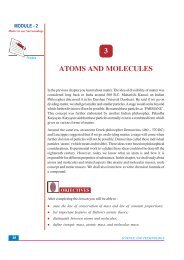NIOS : The Way Forward - The National Institute of Open Schooling
NIOS : The Way Forward - The National Institute of Open Schooling
NIOS : The Way Forward - The National Institute of Open Schooling
You also want an ePaper? Increase the reach of your titles
YUMPU automatically turns print PDFs into web optimized ePapers that Google loves.
<strong>NIOS</strong>: <strong>The</strong> <strong>Way</strong> <strong>Forward</strong> / 45<br />
6<br />
<strong>The</strong> <strong>Way</strong> <strong>Forward</strong><br />
This chapter delineates the directions in which the ODL system and specifically<br />
the <strong>NIOS</strong> and the State <strong>Open</strong> Schools (SOSs) are like to proceed in the future.<br />
It highlights the strategies required to be make ODLS a credible alternative<br />
system <strong>of</strong> education that will also promote the evolution <strong>of</strong> a knowledge society<br />
in India by universalizing education.<br />
6.1 Introduction<br />
6.2 Learning, Development and <strong>Open</strong><br />
<strong>Schooling</strong><br />
6.3 Life Skills: an integral part <strong>of</strong><br />
Modern Curriculum<br />
6.4 <strong>Open</strong> Basic Education Programme<br />
and Sakshar Bharat Programme <strong>of</strong><br />
<strong>National</strong> Literacy Mission (NLM)<br />
6.5 Increasing Access<br />
6.6 Skill Development through<br />
Vocational Education<br />
6.7 Improving the Quality <strong>of</strong> Learner<br />
Support Services<br />
6.8 Research and Development<br />
6.9 Capacity Building <strong>of</strong> ODL<br />
Personnel<br />
6.10 Evaluation <strong>of</strong> Students’<br />
Performances<br />
6.11 Promotion <strong>of</strong> <strong>Open</strong> <strong>Schooling</strong><br />
6.12 Harnessing ICTs in <strong>Open</strong> and<br />
Distance Learning Environment<br />
6.13 Education <strong>of</strong> Special<br />
Disadvantaged Groups<br />
6.14 Implementation Strategies<br />
6.15 Summing Up<br />
6.1 Introduction<br />
We have given a detailed description<br />
<strong>of</strong> the alternate system <strong>of</strong> education<br />
that is rapidly developing worldwide<br />
and in India and have given a full<br />
account <strong>of</strong> the <strong>NIOS</strong> Story. <strong>The</strong><br />
present chapter will spell out several<br />
directions and strategies that need to<br />
be taken so that the <strong>Open</strong> <strong>Schooling</strong><br />
movement is carried forward, as<br />
envisaged in the <strong>National</strong> Education<br />
Policy. Specifically we will talk about<br />
the role and responsibilities <strong>of</strong> the<br />
<strong>NIOS</strong> and <strong>of</strong> the State level <strong>Open</strong><br />
Schools to become agents which will<br />
contribute, in significant measure, to<br />
bring about the transformation <strong>of</strong> the<br />
country, through a sea change in the<br />
quality and quantity <strong>of</strong> educational<br />
provision.<br />
In the recent past, a number <strong>of</strong><br />
significant path breaking initiatives in<br />
terms <strong>of</strong> policy directives as well as<br />
reforms have taken place. <strong>The</strong> most<br />
historic <strong>of</strong> these has been the recent<br />
passing <strong>of</strong> the Right to Education Act.<br />
As per the Act, free and compulsory<br />
education has been made a<br />
Fundamental Right which has to be<br />
provided by the state to all children in the 6-14 age groups.

















